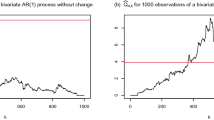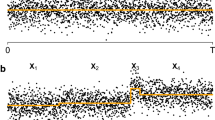Abstract
We consider together the retrospective and the sequential change-point detection in a general class of integer-valued time series. The conditional mean of the process depends on a parameter \(\theta ^*\) which may change over time. We propose procedures which are based on the Poisson quasi-maximum likelihood estimator of the parameter, and where the updated estimator is computed without the historical observations in the sequential framework. For both the retrospective and the sequential detection, the test statistics converge to some distributions obtained from the standard Brownian motion under the null hypothesis of no change and diverge to infinity under the alternative; that is, these procedures are consistent. Some results of simulations as well as real data application are provided.


Similar content being viewed by others
References
Ahmad A, Francq C (2016) Poisson QMLE of count time series models. J Time Ser Anal 37(3):291–314
Aknouche A, Bendjeddou S, Touche N (2018) Negative binomial quasi-likelihood inference for general integer-valued time series models. J Time Ser Anal 39(2):192–211
Bardet JM, Kengne W (2014) Monitoring procedure for parameter change in causal time series. J Multivar Anal 125:204–221
Basseville M, Nikiforov IV et al (1993) Detection of abrupt changes: theory and application, vol 104. Prentice Hall, Englewood Cliffs
Billingsley P (1968) Convergence of probability measures. Wiley, London
Chow Y (1960) A martingale inequality and the law of large numbers. Proc Am Math Soc 11(1):107–111
Chu CSJ, Stinchcombe M, White H (1996) Monitoring structural change. Econom J Econ Soc 64:1045–1065
Csörgo M, Csörgo S, Horváth L, Mason DM (1986) Weighted empirical and quantile processes. Ann Prob 41:31–85
Diop ML, Kengne W (2017) Testing parameter change in general integer-valued time series. J Time Ser Anal 38(6):880–894
Diop ML, Kengne W (2021) Piecewise autoregression for general integer-valued time series. J Stat Plan Inference 211:271–286
Doukhan P, Kengne W (2015) Inference and testing for structural change in general Poisson autoregressive models. Electron J Stat 9:1267–1314
Fokianos K, Rahbek A, Tjøstheim D (2009) Poisson autoregression. J Am Stat Assoc 104(488):1430–1439
Grunwald GK, Hyndman RJ, Tedesco L, Tweedie RL (2000) Theory & methods: non-gaussian conditional linear ar (1) models. Aust N Z J Stat 42(4):479–495
Kang J, Lee S (2014) Parameter change test for Poisson autoregressive models. Scand J Stat 41(4):1136–1152
Kang J, Song J (2017) Score test for parameter change in Poisson autoregressive models. Econ Lett 160:33–37
Kang J, Song J (2020) A robust approach for testing parameter change in Poisson autoregressive models. J Korean Stat Soc 49(4):1285–1302
Kengne W, Ngongo IS (2020) Inference for nonstationary time series of counts with application to change-point problems. ar**v preprint ar**v:2005.00934
Kirch C, Kamgaing JT (2015) On the use of estimating functions in monitoring time series for change points. J Stat Plan Inference 161:25–49
Kirch C, Tajduidje Kamgaing J (2016) Detection of change points in discrete valued time series. In: Holan SA, Lund RB, Ravishanker N, Davis RA (eds) Handbook of discrete valued time series. CRC Press, Boca Raton
Kirch C, Weber S (2018) Modified sequential change point procedures based on estimating functions. Electron J Stat 12(1):1579–1613
Lee S, Ha J, Na O, Na S (2003) The cusum test for parameter change in time series models. Scand J Stat 30(4):781–796
Leisch F, Hornik K, Kuan CM (2000) Monitoring structural changes with the generalized fluctuation test. Econom Theory 16(06):835–854
Weiß CH (2011) Detecting mean increases in Poisson INAR (1) processes with EWMA control charts. J Appl Stat 38(2):383–398
Weiß CH, Testik MC (2011) The Poisson INAR (1) CUSUM chart under overdispersion and estimation error. IIE Trans 43(11):805–818
Weiß CH, Feld MHJ, Mamode Khan N, Sunecher Y (2019) INARMA modeling of count time series. Stats 2(2):284–320
Yontay P, Weiß CH, Testik MC, Pelin Bayindir Z (2013) A two-sided cumulative sum chart for first-order integer-valued autoregressive processes of Poisson counts. Qual Reliab Eng Int 29(1):33–42
Zeileis A, Leisch F, Kleiber C, Hornik K (2005) Monitoring structural change in dynamic econometric models. J Appl Econom 20(1):99–121
Zhu F (2011) A negative binomial integer-valued GARCH model. J Time Ser Anal 32(1):54–67
Zhu F (2012) Modeling time series of counts with COM-Poisson INGARCH models. Math Comput Model 56(9–10):191–203
Acknowledgements
The authors are grateful to the Editor, the Associate Editor and the two anonymous Referees for many relevant suggestions and comments which helped to improve the contents of this article.
Author information
Authors and Affiliations
Corresponding author
Additional information
Publisher's Note
Springer Nature remains neutral with regard to jurisdictional claims in published maps and institutional affiliations.
M. L. Diop and W. Kengne: Supported by the MME-DII center of excellence (ANR-11-LABEX-0023-01) and the ANR BREAKRISK: ANR-17-CE26-0001-01. W. Kengne: Developed within the CY Initiative of Excellence (Grant “Investissements d’Avenir” ANR-16-IDEX-0008), Project “EcoDep” PSI-AAP2020-0000000013.
Rights and permissions
About this article
Cite this article
Diop, M.L., Kengne, W. Poisson QMLE for change-point detection in general integer-valued time series models. Metrika 85, 373–403 (2022). https://doi.org/10.1007/s00184-021-00834-1
Received:
Accepted:
Published:
Issue Date:
DOI: https://doi.org/10.1007/s00184-021-00834-1
Keywords
- Change-point
- Retrospective detection
- Sequential detection
- Integer-valued time series
- Poisson quasi-maximum likelihood




